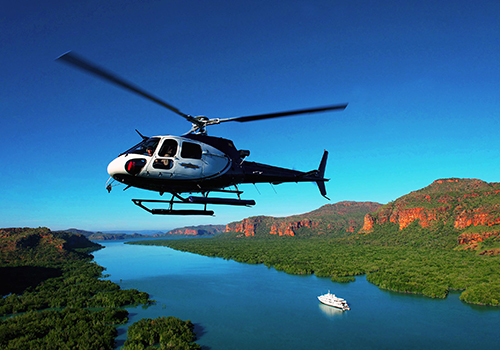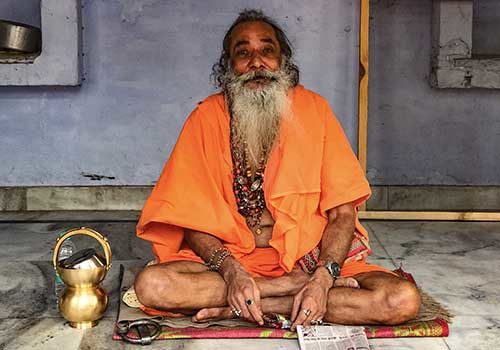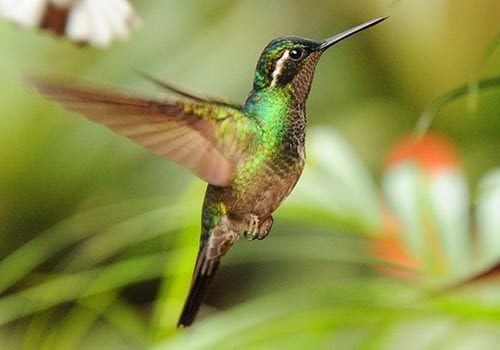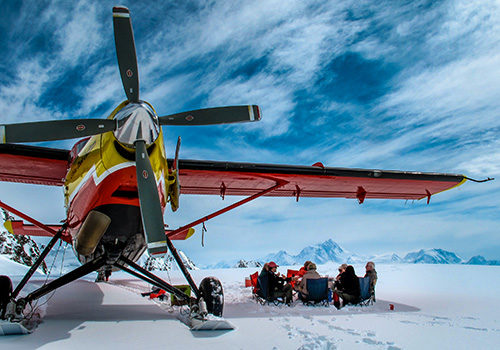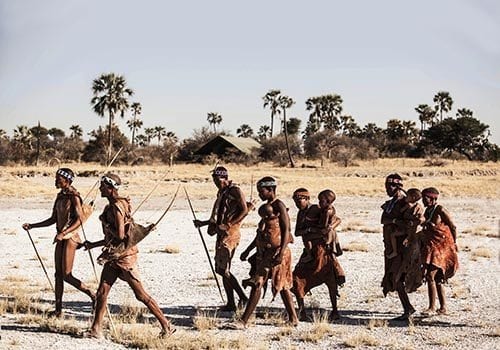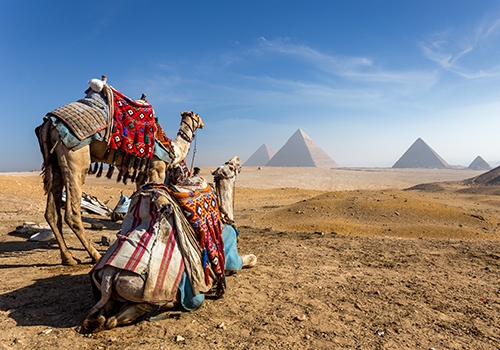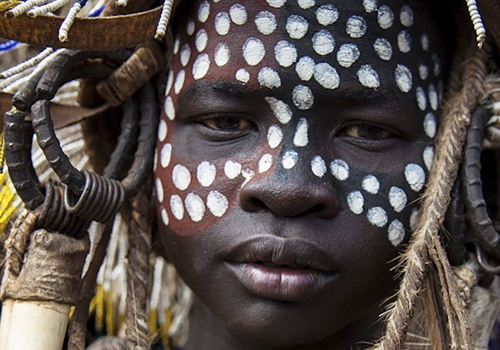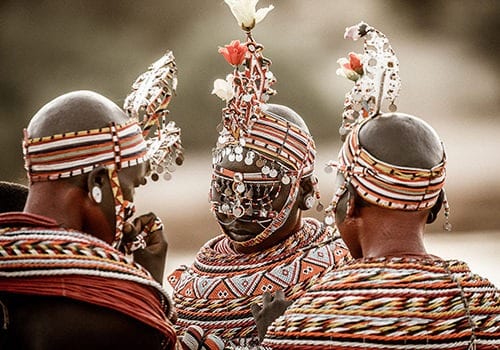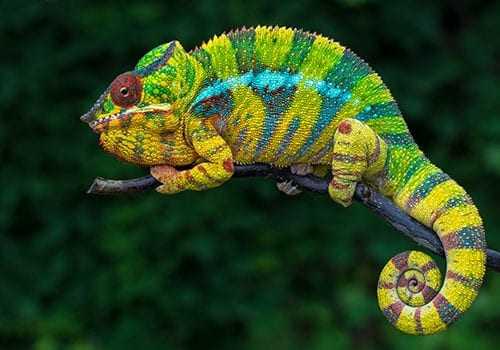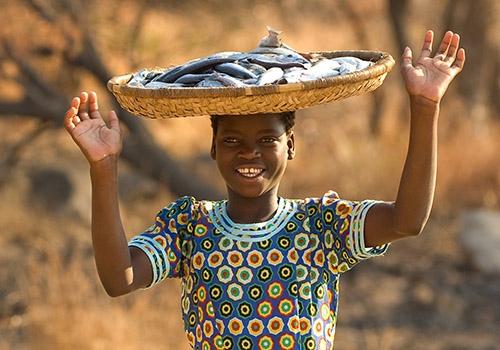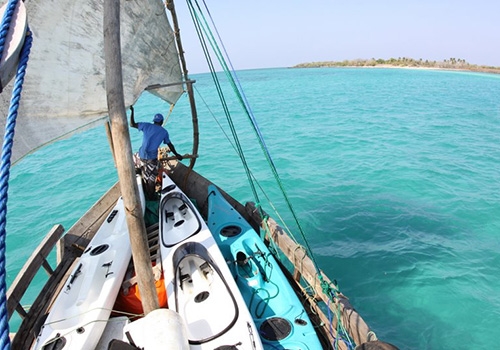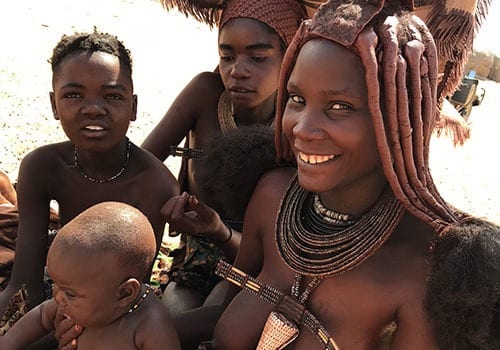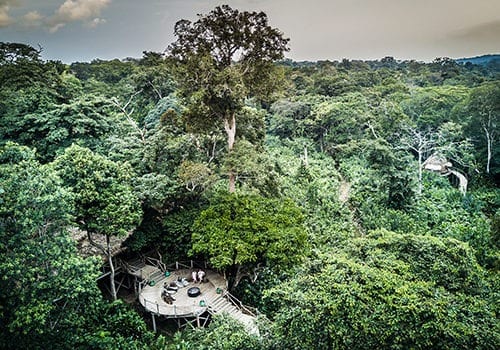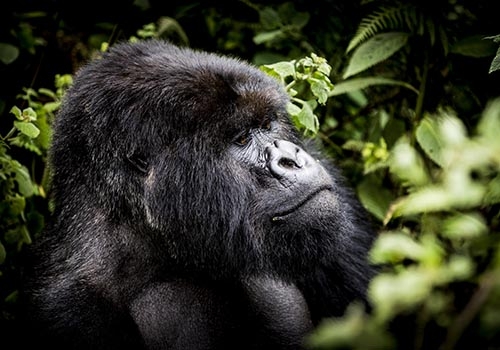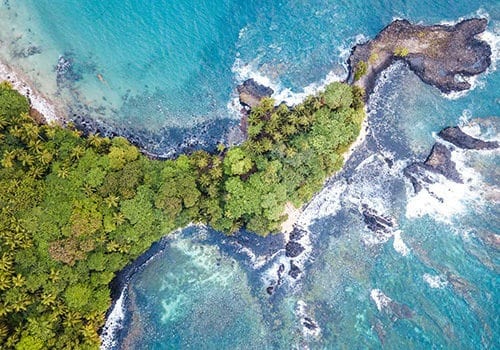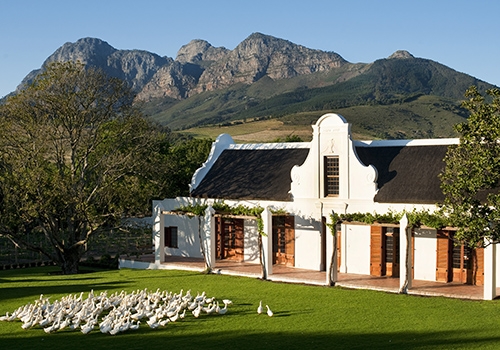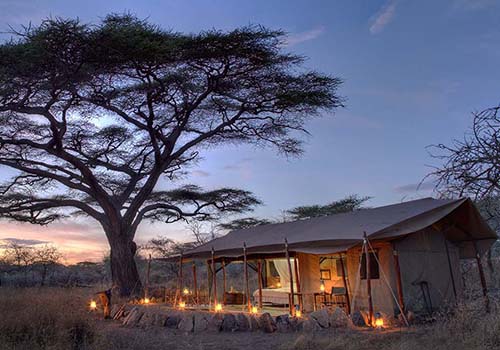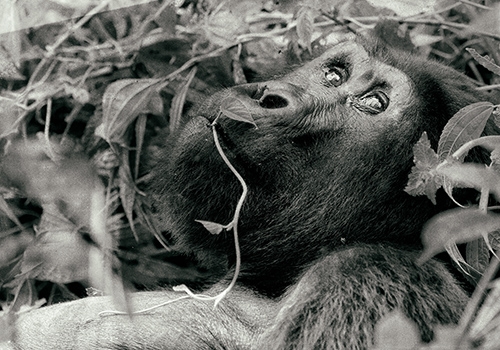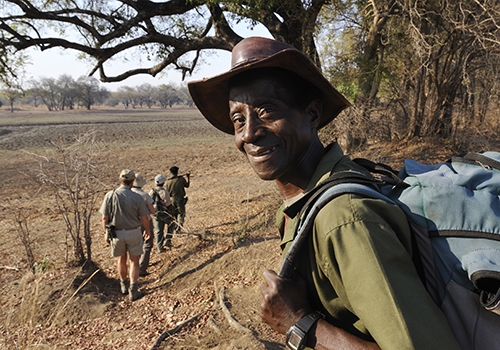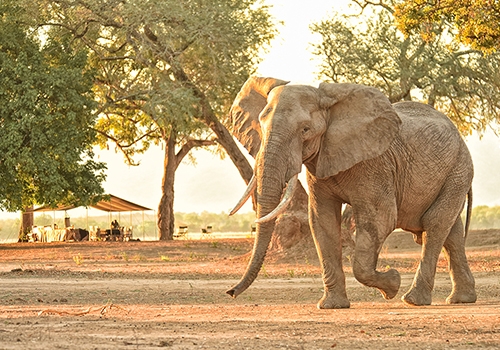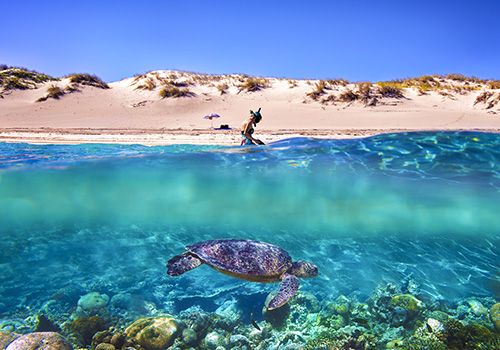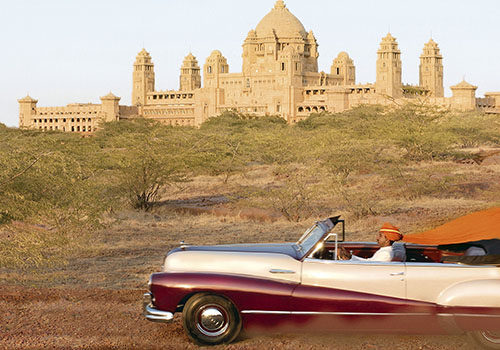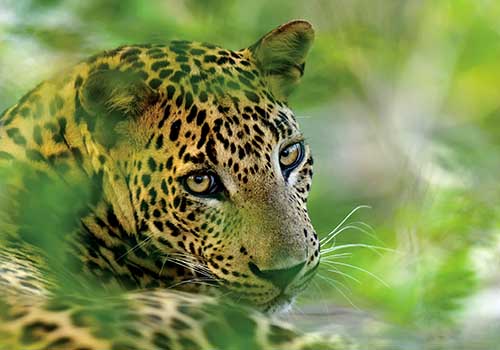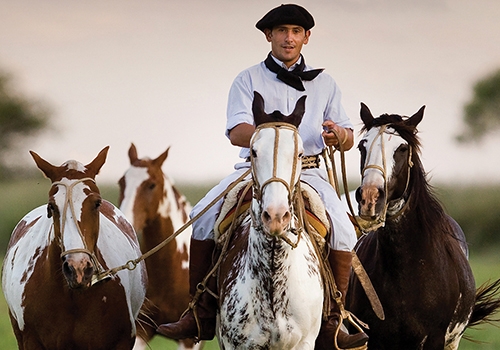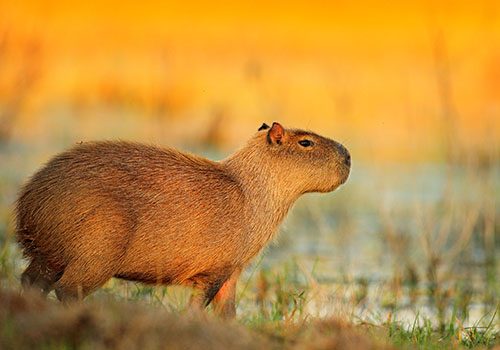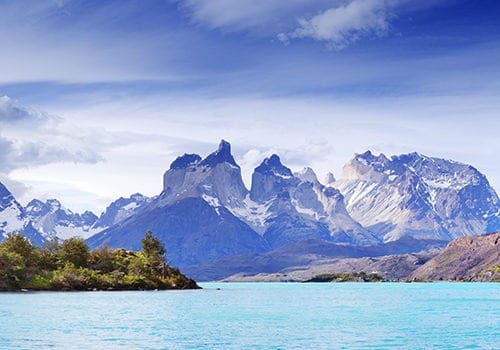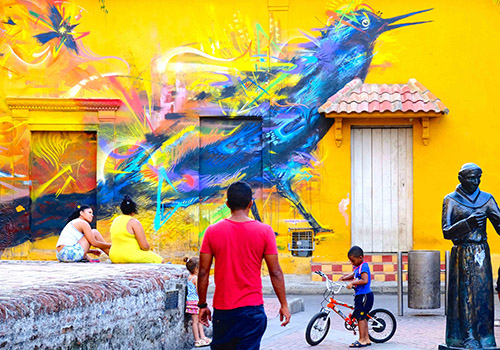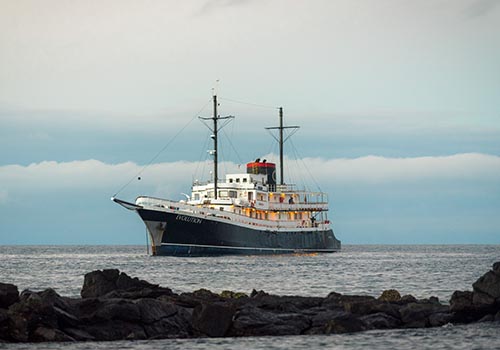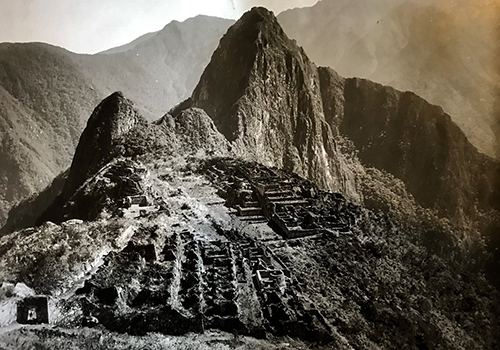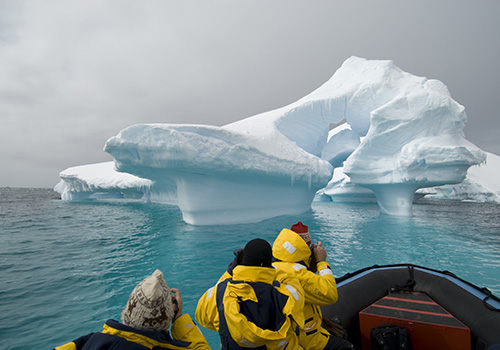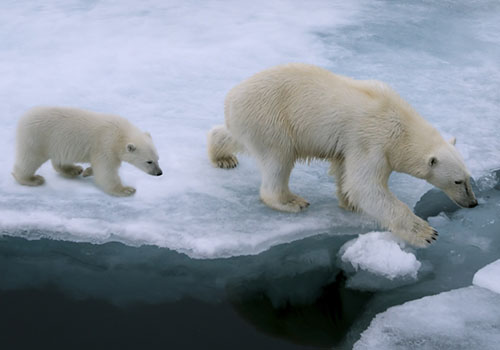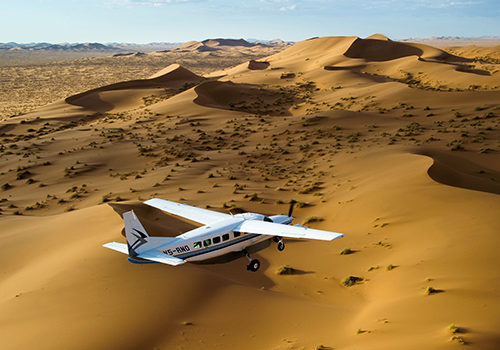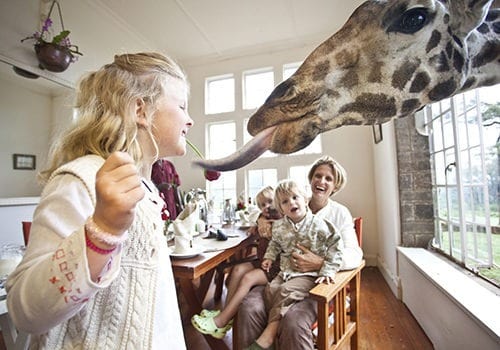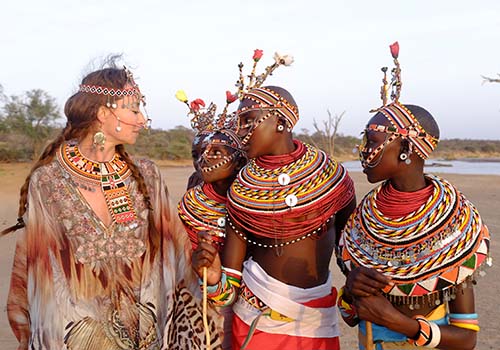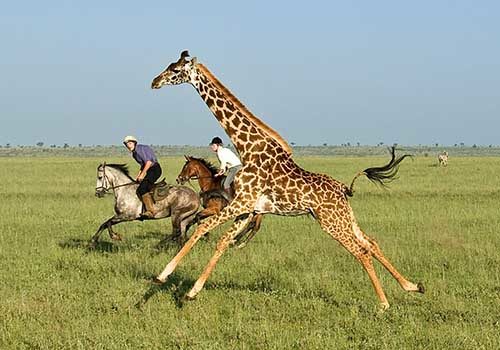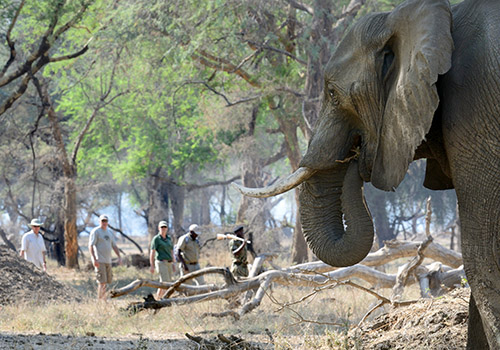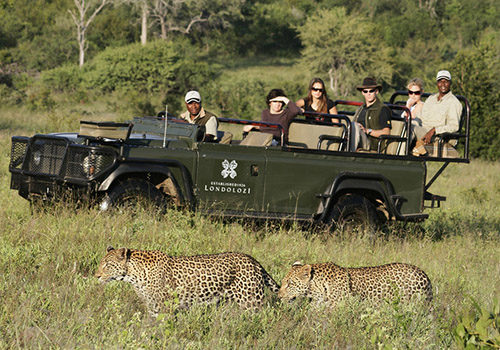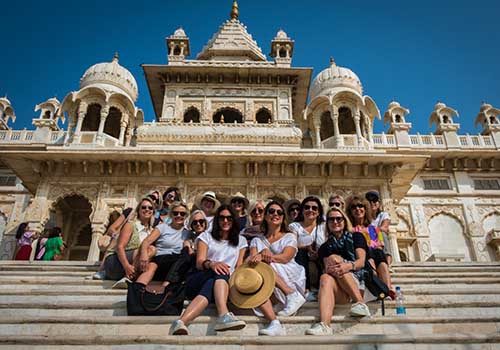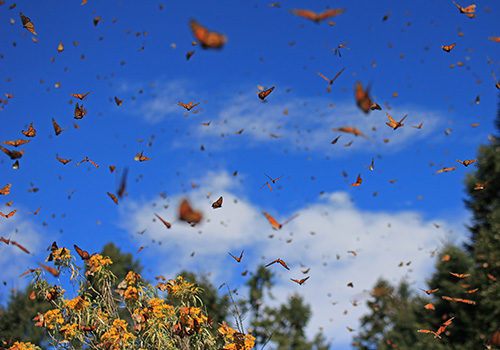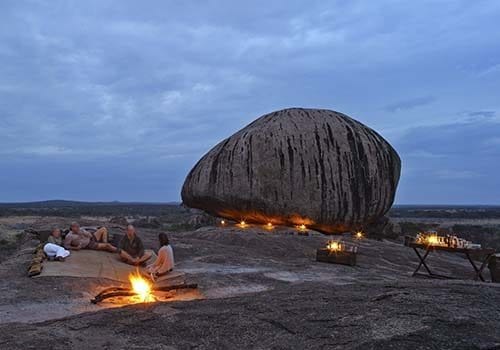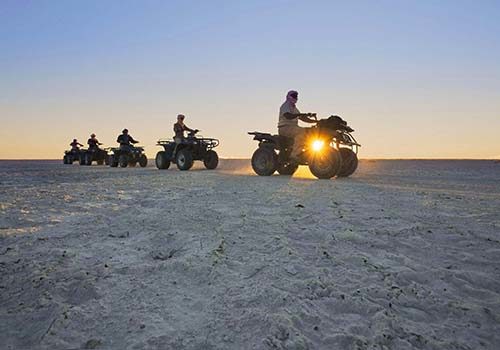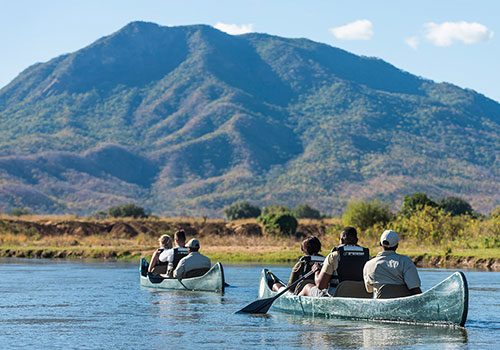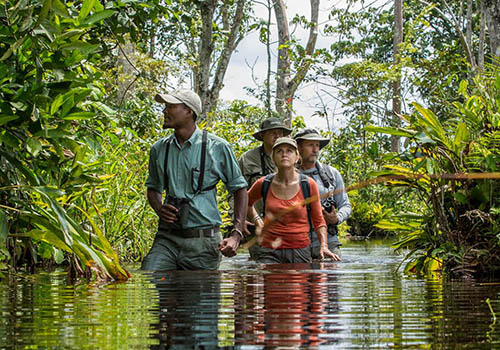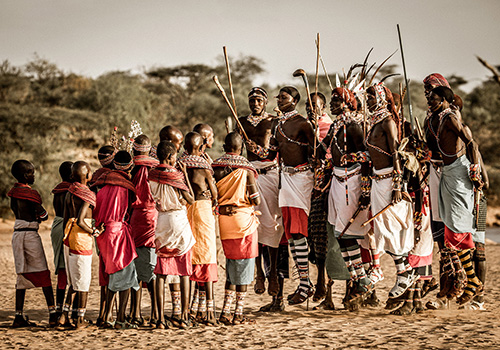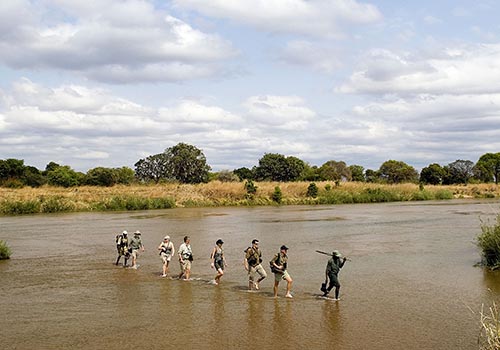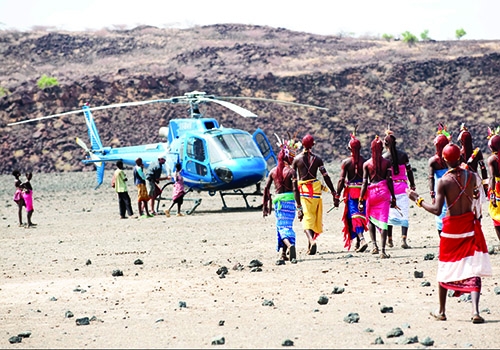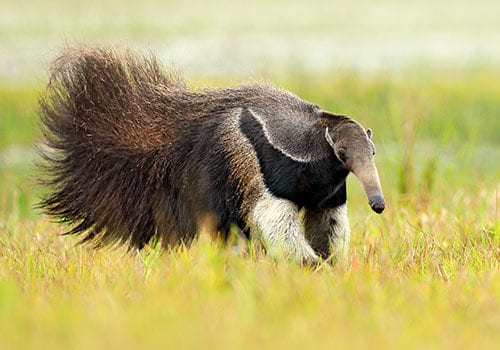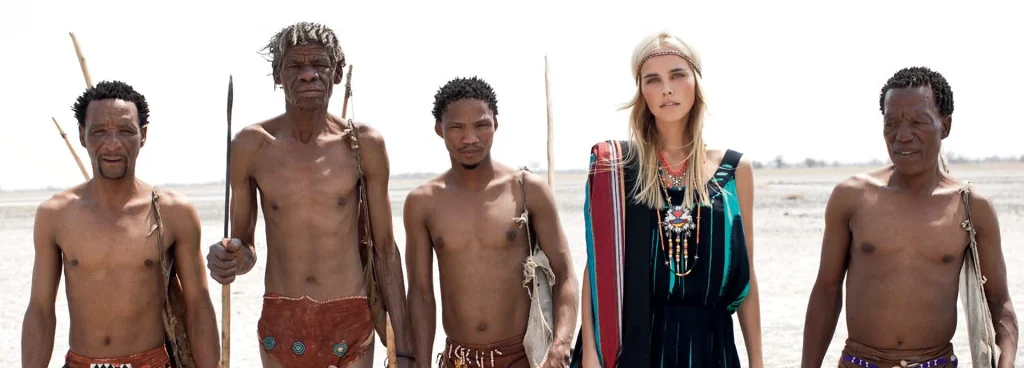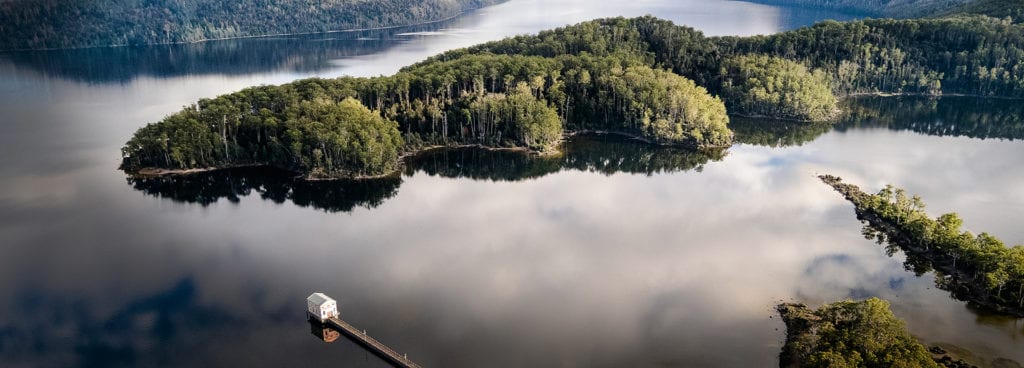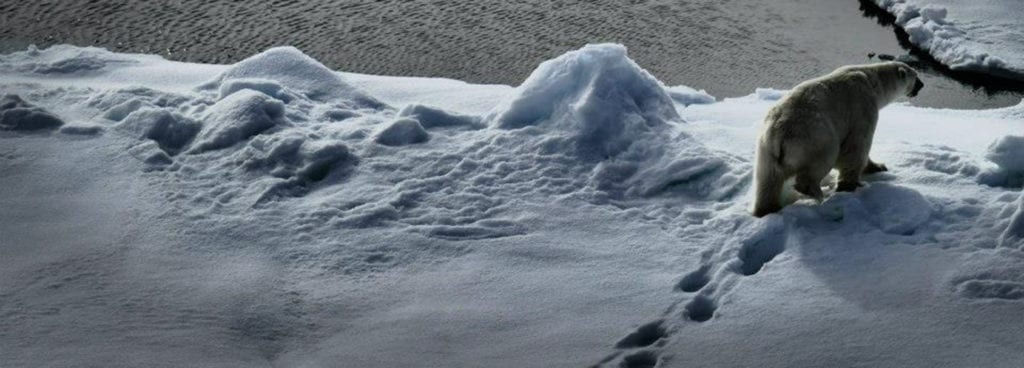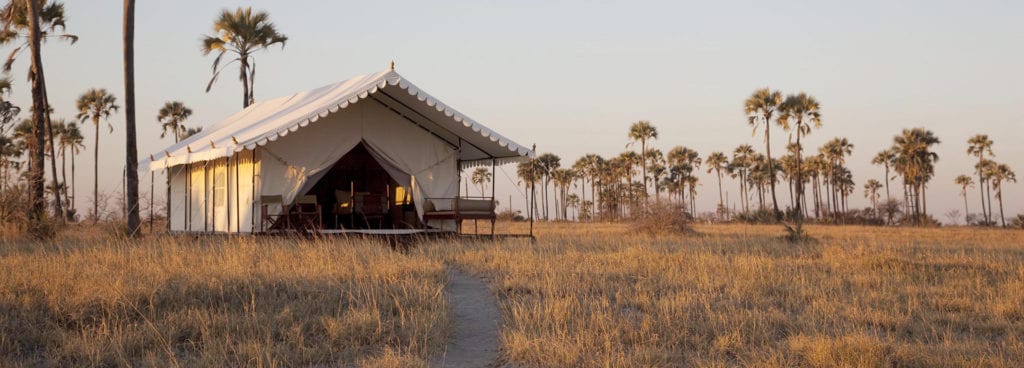DISPATCHES FROM EXOTIC LANDS
Walking with Wildlife in Kenya
The Ultimate Adventure
– Excerpt from Sydney Morning Herald Traveller Magazine, Jan 27, 2025 – by Julie Miller
Finger to lips, Washii ushers us over a fallen log to gather on the edge of a river bank. Several metres below, in the caffe latte-coloured waters of the Tsavo River, a herd of 10 African elephants – from monumental tusked matriarchs to dumpling babies, appendages akimbo – are bathing, oblivious to our presence upwind.
For several minutes we admire in silence, muscles locked so as not to disturb this tranquil scene. Then, thirst sated, the mamas usher their splashing youngsters out of the shallows onto the bank, with just a narrow gulch dividing us.
Our guide, Iain Allan, raises a hand to indicate we wait and stand our ground. Even as the lead elephant suddenly becomes aware of 14 humans too close for comfort, we remain statue-like, albeit hearts galloping, as she flaps her ears and raises her trunk in a gesture of caution.
The herd matriarch bringing up the rear is more forthright. She rolls her head and whips her trunk in a definitive warning as Iain responds with a gentle “hup!”. It’s enough to stop her in her tracks and send the group passively on its way.
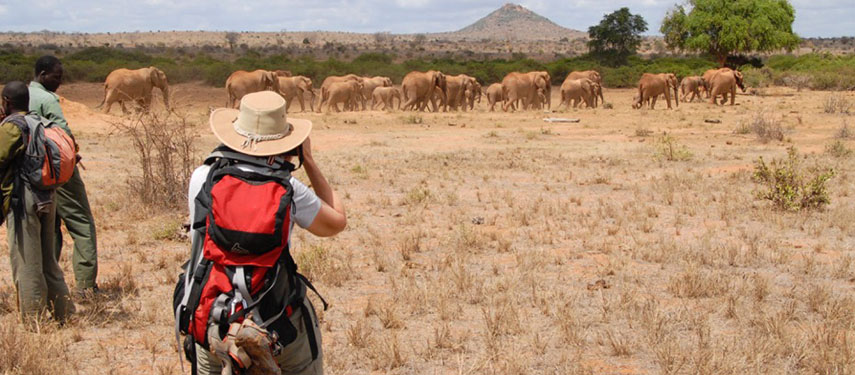
Exhale. Then there is the whispered chorus of “oh my god” as we relish this intimate encounter with the most charismatic beast of the African plains.
This is why we’ve travelled into the wilds of Kenya, enduring heat, dust and seeping blisters – for the opportunity to view wildlife on its terms, unencumbered by iron and steel, immersed in their environment and essentially part of the food chain.
For 10 days, our group of eight international adventurers – three recently retired American women, a father and his two adult sons from Scotland, a local Kenyan man and myself – will hike through Kenya’s largest wilderness, 22,812 square kilometres in the shadow of Mount Kilimanjaro south-east of Nairobi, administered as two separate national parks, Tsavo West and East.
• • •
DAY ONE
Nairobi to Kilaguni Lodge, Tsavo West National Park
While we are all aware of the enormity of the physical challenge at hand – I’ve certainly never walked 160 kilometres all at once – the realities of the potential danger of this undertaking soon becomes apparent in the most exigent of safety briefings.
We’ll be walking single file in absolute silence for five hours a day: Iain leading the way, armed with a .416 Rigby elephant rifle, followed by Washii, a Samburu tracker wielding a spear, and the lofty Tioko, also carrying a rifle.
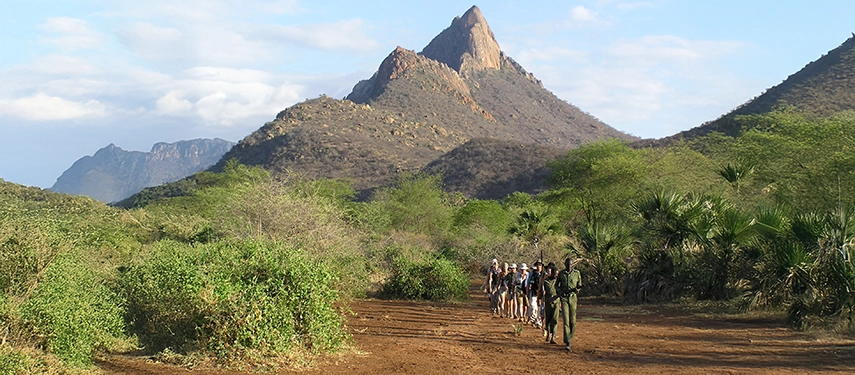
At the end of the line will be another two armed bushmen, Etukan and Lokorio, with hawk-like eyes capable of spotting game from impossible distances.
For our safety, we are to obey our guides’ every command, tuning into their body language as they scan the dense tangle of foliage for lurking creatures.
It’s serious stuff, though presented with a touch of much-needed levity with Allan’s wry “If you get it wrong, go with dignity” advice becoming a much-repeated catchphrase throughout our journey.
Killing an estimated 500 people a year, the animal to be most wary of is the hippo – a territorial beast that will charge on instinct, blind with unstoppable rage if the path between it and its aqueous home is blocked.
With Kenya suffering prolonged drought, hippos are being forced further afield to graze each night, their delayed return to the river creating a potentially volatile situation. And when it comes to guest safety, there’s no choice for an enraged hippo but to come off second best.
Elephants, though equally foreboding, are a different story: they are smart, evolved animals, capable of reason and complex thought processes.
“The elephant is one of the most supreme creatures on this planet,” Allan says, totally enamoured with the animal he has been studying his whole adult life.
An irate elephant should respond to a warning shout, or at worst a shot fired above its head: “The day I am forced to shoot an elephant is the day I give this up,” Iain tells us.
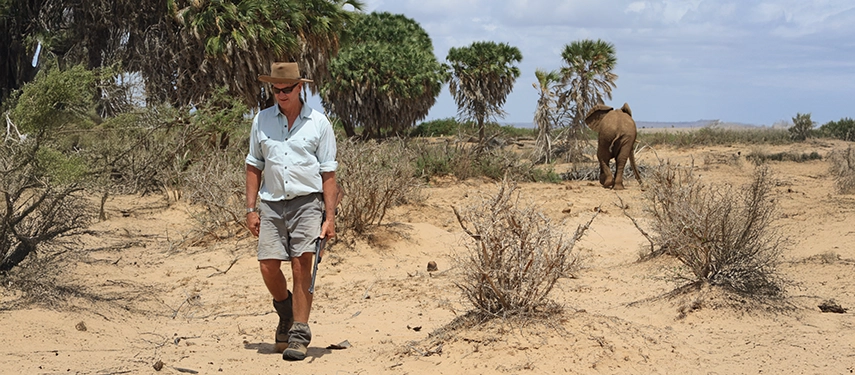
DAYS TWO & THREE
Overnight Kudu Camp & Kichwa Tembo Camp
In Out of Africa, Danish author Karen Blixen described the low country of Kenya as having “no fat on it and no luxuriance anywhere”.
As we begin our silent progression the following morning from the source of the Tsavo River at Mzima Springs, there’s something difficult to comprehend.
How can such a rugged, lean landscape, characterised by red volcanic soil and barbed acacia bushes that clutch and tear at skin and hair, sustain any wildlife, let alone more than 13,000 elephants – including most of Africa’s few remaining “super tuskers”.
Tsavo West is big game country: rather than the teeming herds of grazers found further east or on the open plains of the Maasai Mara, it’s Africa’s giants that dominate the acacia woodlands, with elephants, hippos and Cape buffalo responsible not only for the age-old trails we duck and weave along but also the most intense sightings.
With few tourists, the wildlife in Tsavo is not used to the presence of vehicles, let alone hikers on foot; and for many elephants, humans are associated with the terrors of poaching, which decimated their numbers during the ’70s and ’80s.
One lone bull elephant, camouflaged in dense foliage just metres away, lets his displeasure be known with a mock charge before making his retreat; while we respectfully skirt around a foraging family group crossing our path, ushered through prickly barricades of “wait-a-bit” thorns in hasty silence by Washii and Tioko.
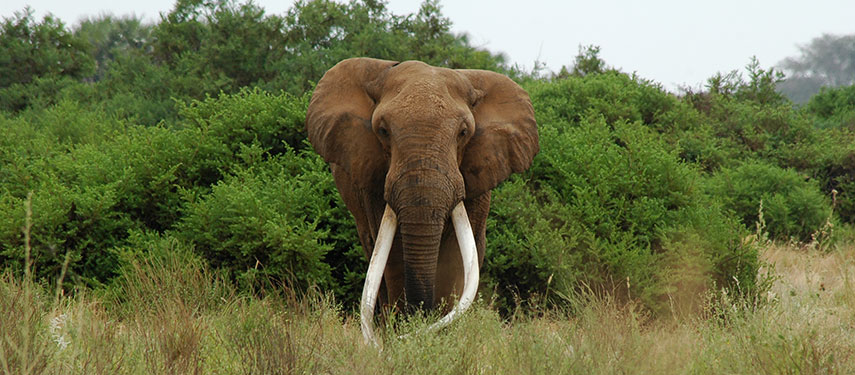
Meanwhile, our intimate vantage point reveals the less feted creatures of the scrublands; a family of warthogs, scuffing through the dust; tiny dik-dik, the smallest of the antelope family, erupting from thorny clumps; even a puff adder, curled up in a rock crevice in silent wait for passing prey.
Elegant giraffes waltz across the horizon; fringe-eared oryx pierce the sky with unicorn horns; while Iain’s warnings about errant hippos is realised early on our second walk, resulting in raised firearms, a rapid retreat and surging adrenaline but thankfully nothing more dramatic.
Day two of our walk also sees the first of 18 river crossings, a nerve-wracking experience. Boots removed, we cross at the widest and shallowest points of the river at known elephant crossings, where crocs and hippos are less likely to lurk; linking arms with a chosen partner, we move as a tight unit, emulating pachyderms with stomping legs.
• • •
DAY SIX TO EIGHT
Tsavo East National Park & Epiya Chapeyu Camp
The wilderness of Tsavo West and East National Parks is divided by two jarring man-made anomalies: a highway and a railway line, both linking the port of Mombasa to the capital Nairobi and beyond.
It was during the building of the railroad bridge in 1898 that Tsavo’s most infamous man versus animal conflict entered both history and legend, recorded by the railway project manager Lieutenant-Colonel John Patterson in his book, The Man-eaters of Tsavo.
For nine months, two Tsavo lions – nicknamed Ghost and the Darkness – terrorised the construction campsites, dragging dozens of hapless Indian workers from their tents at night and devouring them.
The official death toll was at least 35 with more than 100 workers unaccounted for. Scientific studies on the corpses of the lions – eventually shot by Patterson himself – revealed humans made up 30 per cent of their diet.
In typical theatrical manner, Allan leads us down a trail near the highway, producing a dog-eared second edition copy of Patterson’s book and reading a passage where he finds the so-called den of the man-eaters.
Then, lo and behold, around a corner we spy the actual rocky overhang, matching the photograph in the book – a location discovered by Allan himself during a search in the 1990s.
From the sadly dilapidated Tsavo Railway Station, we notice a marked shift in the landscape, the meandering Galana River, a lifeline for massive herds of zebra, giraffe, impala and buffalo that make a daily trek through arid flatlands to its white sandy beaches.
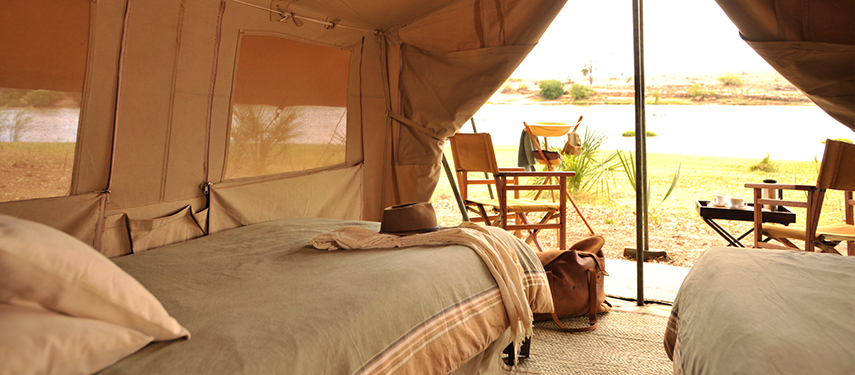
This is also ideal lion country, the apex predators lying in lazy anticipation for grazers to appear, dozing in the shade of scrubby saltbush during the heat of day.
As predicted earlier by Allan, our first encounter with lions on foot is somewhat of an anti-climax. First spotted by Etukan at the back of the line as we scramble up a dry creek bed, Iain practically stumbles into the pride at the front, spooking them from their slumber under a stunted coastal oak.
Beckoned back down the hill by Etukan, I am discombobulated as Allan also urges me forward for a closer view; and by the time I fix my gaze on the skittish simba, they are bounding into the distance. “See, lions aren’t the king of the jungle,” Allan says. “Elephants are.”
In this thirsty landscape, home base has become even more enticing – we now have the luxury of three nights in a row spent at two camps, riverside leases exclusive to Tropical Ice.
The first, Epiya Chapeyu, is postcard perfect, occupying a wide bend of the Galana with a resort-worthy white sand beach and palm-lined banks occupied by two resident bull elephants.
Binoculars raised, we while away time gazing at these regal tuskers ambling across the river, trunks raised in seemingly congenial greeting. I wake one night to enormous black shadows passing silently by my tent and I’m unsure if I am hallucinating. I later find fresh dung and footprints as evidence of the midnight rendezvous.
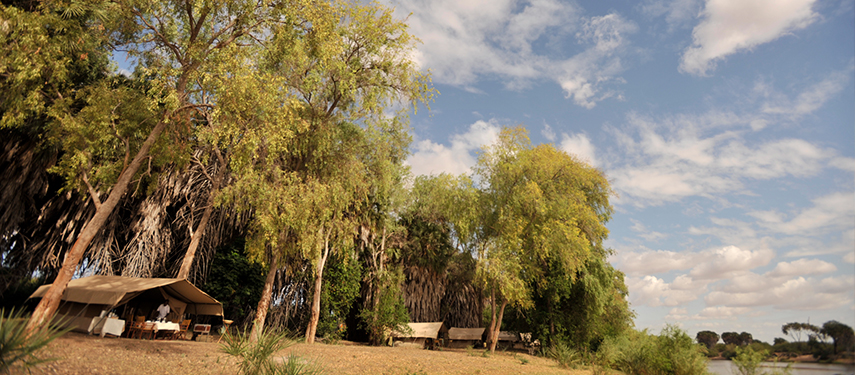
• • •
FIVE MORE ANIMALS TO SPOT ON SAFARI
Gerenuk
Also known as the “giraffe gazelle”, this long-necked antelope with manga eyes and comical ears is the most perfectly adapted of Tsavo’s wildlife, gaining all of its water requirements from grazing and foraging.
Hyena
It’s always exciting to see Africa’s predators on the hunt. While arguably the most maligned creature of Africa, there’s a lot to admire about this fascinating dog-like pack-hunter and scavenger.
Red-Billed Quelea
Every evening sees massive flocks of this tiny bird – the most populous undomesticated bird in the world with an estimate of 1.2 billion individuals – create smoke-like plumes as they swarm from feeding grounds back to their evening perch.
Cape Buffalo
After hippos, a lone bull Cape buffalo is the most feared creature to encounter on a walking safari and must always be treated with caution. To witness huge herds as they descend on the river for their daily quench is an incredible, humbling sight.
Puff Adder
Samburu warriors may be fearless in the face of a charging elephant but one creature they do fear is the deadly puff adder. Able to remain invisible in ground cover, our group experienced two adrenaline pumping encounters with this venomous viper.
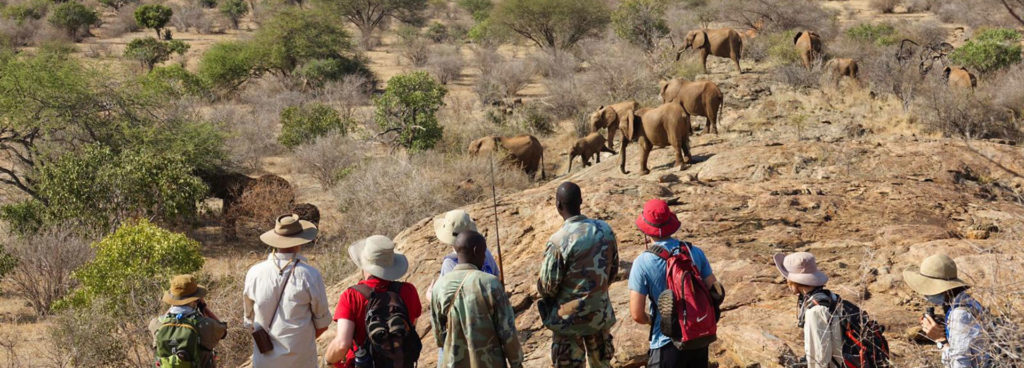
THE WALK
The 14-day Great Walk of Africa includes internal flights within Kenya, 10 days of hiking, all-inclusive fully deluxe camping, guides, staff and park permit fees.
• • •
Julie Miller scrapes a living writing about the things she loves: travel, riding horses and drinking cocktails on tropical beaches. Between airports, she lives in a rural retreat just beyond Sydney.
READ THIS ARTICLE IN FULL NOW AT SYDNEY MORNING HERALD’S TRAVELLER MAGAZINE

